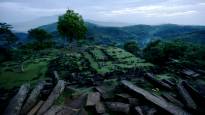A prehistoric structure hidden inside a hill on the island of Java may be several thousand years older than the pyramids of Egypt, claims a new study.
The megalithic site of Gunung Padang, located on the island of Java in Indonesia, may hide the world’s oldest pyramid, researchers estimated in a study published in October.
The Indonesian research team used several techniques, for example radiocarbon dating, drilling and ground probes, to uncover the structure’s secrets. Peer-reviewed research is published in Archaeological Prospection.
Gunung Padang means “Mountain of Enlightenment” in the local language. Religious rituals may have been performed there. The Dutch rediscovered the site in 1890.
Researchers estimate that Gunung Padang is not a natural hill but a pyramidal structure. The core of the pyramid probably consists of precisely molded andesite, i.e. cooled lava. Layers of stone structures have been added around it.
The site has been supplemented over thousands of years
According to radiocarbon dating, the oldest part of the structure would have been built during the last ice age, sometime between 25,000 and 14,000 years before the start of the countdown. The pyramid could therefore be up to 27,000 years old.
If this is true, Gunung Padang would be more than 20,000 years older than the Egyptian pyramids. It would also be thousands of years older than Göpekli Tepe, which was built about 9,000 years before the start of time. Located in Turkey, Göpekli Tepe is considered the oldest temple in the world.
According to the study, the first builders of Gunung Padang had later abandoned the site for thousands of years. Then the structure was deliberately buried underground about 7,000 years before the start of the countdown.
Radiocarbon dating suggests that the multi-layered structure would have been continued in different eras.
The next builders came to Gunung Padang and built a new part on top of the old one between 6,000 and 5,500 BC.
The last part of the pyramid, i.e. the stone terraces visible today on top of the hill, was built sometime between 2,000 and 1,100 years before the start of the countdown, the study claims.
Human history would be renewed
Researchers claim to have found evidence of a possible large underground chamber inside the mound.
– Gunung Padang is a unique legacy, and it is possibly the world’s oldest pyramid. Further interdisciplinary research will reveal its hidden secrets and tell more about the ancient civilizations that flourished in this enigmatic place, the researchers write.
It is not known who built Gudung Padang and why. If the estimated construction time of the site is correct, the pyramid would have been built before the invention of agriculture and thousands of years before the first known civilizations.
The researchers estimate that the builders must have had knowledge of advanced masonry skills already during the last ice age. This challenges the current understanding that human civilization and building techniques only developed in the warm period that started after the ice age.
The burial of Gunung Padang some 9,000 years ago raises questions, researchers say. They have no answer as to why the object was decided to be hidden. The researchers believe that in the future it would be important to organize excavations to obtain additional information about possible underground structures.
There are controversies surrounding the site
The previous president of Indonesia, a retired general Susilo Bambang Yudhoyono was very enthusiastic about the research related to Gunung Padang, wrote the Australian The Sydney Morning Herald in 2013. Various parties have studied the site at least since the 1980s.
According to the newspaper, determining the age of the ancient site had taken on shades of a nationalist task. At the time, 34 Indonesian archeologists and geologists had written a petition to Yudhoyono in which they expressed their suspicions about Hilman’s team’s research methods and motives.
Over the past year, Gunung Padang has gained attention as it is featured in the Netflix series Ancient Apocalypse.
That’s a British writer Graham Hancock presents his controversial theory that a civilization flourished during the Ice Age, which was destroyed in some kind of upheaval, possibly as a result of a meteorite hitting the Earth.
Many archaeologists and experts have dismissed Hancock’s theories.
At the end of their research, Hilman and his research team thank Hancock for proofreading their manuscript and bringing Gunung Padang to the fore in Ancient Apocalypse.
You can discuss the topic until Thursday, November 8 at 11 p.m.
